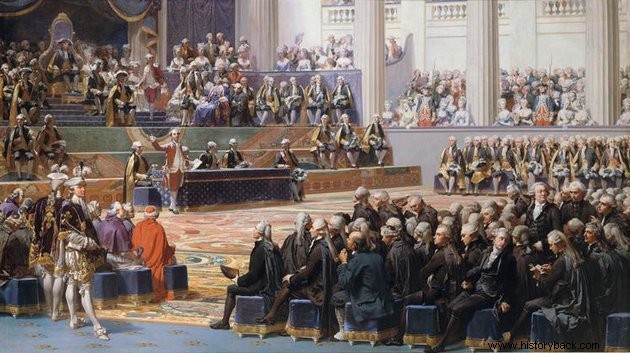The proclamation of the National Constituent Assembly in France took place on July 9, 1789 .
Two years later, on September 3, 1791, a Constitution was adopted that ended the Ancien Régime and established the Constitutional Monarchy in France.
French Constitution of 1791
The French Constitution of 1791 had as main features:
Form and Regime of Government
The monarchy would be the government regime, but it would become constitutional. The Bourbon family would continue to reign and Louis XVI would remain on the throne.
The king had veto power, was the Chief of the Armed Forces and declared war and peace.
See also:Constitutional MonarchyDivision of Powers
The Constitution established the division of powers, as the Enlightenment advocated. Thus, France now has:
- Executive power:exercised by the king
- Legislative Power:745 deputies
- Judiciary:judges elected by citizens
Civil Equality
There was the abolition of feudalism and civil equality was proclaimed, that is, privileges and social orders were suppressed. Still, slavery was maintained in the colonies.
Protestants and Jews are recognized as citizens.
Census Vote
A form of census vote was established based on economic criteria. Citizens were divided into assets, those who could vote; and passive, who did not participate in the elections, such as women, Jews and former slaves.
Only men over 25 years of age, established at the same address for one year and paying a tax equivalent to three days' work, could vote.
They voted for national deputies, local assemblies, judges, heads of the national guard and priests.
On the other hand, in order to apply, it was necessary to have an income equivalent to fifty days' work.
See also:Census VoteWork
Trade unions and guilds were suppressed, as well as the workers' right of association and strike.
Religion
In 1790, the Civil Constitution of the Clergy was approved, in which priests became subordinate civil servants and paid by the State. Likewise, priests should take an oath to the Constitution.
Church property was also confiscated, the end of perpetual vows was declared and religious orders suppressed.
This set of laws was ratified by the Constituent Assembly of 1791 and incorporated into the Constitution.
Origin of the National Constituent Assembly

The antecedents for the formation of the national constituent assembly began with the convocation of the Estates General.
The Estates General were formed by:
- First State :clergy, comprising about 120,000 religious.
- Second State :nobility and totaled approximately 350,000 members of the palatial nobility, provincial nobility and toga nobility – bourgeois who bought noble titles.
- Third State :bourgeois and was made up of at least 24 million people and on whom taxes fell. There were no representatives of peasants in this segment, although they belonged to the Third Estate.
Convocation of the States General
King Louis XVI appointed Minister Jacques Turgot (1727-1781) to carry out a tax reform. The name was rejected and Calonne (1734-1802) accepted the task by convening the Assembly of Notables, formed by the First and Second Estates.
The minister proposed to the two states that they abdicate their privileges and start paying taxes to alleviate the financial chaos experienced by France. The French foreign debt reached 5 million pounds.
Again, the proposition was rejected and a new minister, Jacques Neccker (1732-1804), managed to convince the king to convoke the Assembly of the Estates General, composed of the three estates.
The idea was that the Third Estate would keep all the taxes, but the urban mass, with greater representation, rejected it.
With the impasse, on June 20, 1789, the Third Estate, supported by some sectors of the First and Second Estates, decided to separate from the Estates General. Thus, they proclaimed themselves as the true assembly of the French.
King Louis XVI proclaimed the opening of the National Constituent Assembly on July 9, 1789. The sovereign was haunted by the economic crisis, the failure of the grain harvest hit by drought and the alignment of French thinkers with the Independence of the United States.
The objective was to buy time and lead the troops to contain the revolutionaries. However, the movement was already on the streets. On July 13, the Paris Militia is formed, a people's military organization, and on July 14, the Bastille takes place.
See also:Storming of the Bastille (1789)Declaration of the Rights of Man and Citizen

As a way of containing the movement, the members of the National Constituent Assembly met between August 4 and 26, 1789 to approve the abolition of feudal rights and the Declaration of the Rights of Man and Citizen.
Inspired by Enlightenment ideas, the Declaration promised the individual's right to liberty, equality before the law, the inviolability of patrimony, property and the right to resist oppression. These principles would be present in the Magna Carta of 1791, but the king refused to approve the Declaration.
Revolted, a large group of women went to Versailles to demand bread, an end to the occupation of Paris by the army and for the king to move to Paris. The sovereign accepts the conditions and becomes, practically, a prisoner of the revolutionaries.
Pressured from all sides, the king decides to flee with his family, but is discovered in the city of Varennes. From there he is escorted by the army back to Paris.
See also:EnlightenmentCuriosities
- The Constitution of 1791 provided for a project to unify the units of weights and measures in France and this generated a huge revolt among the peasants, as each French region had its own unit of measurement.
- The Civil Constitution of the Clergy divided the population and the religious. As priests were supposed to swear to the Constitution to show their adherence to the new government, these were called constitutional or sworn priests, but were rejected by the faithful.
Read more :
- Old Regime
- French Revolution
- Terror in the French Revolution
- French Republic
- France
- Flag of France
- Questions about the French Revolution
